The Occult Truths of Old Myths and Legends
GA 211
1 April 1922, Dornach
Translated by Steiner Online Library
VI. The Exploration and Formulation of the World Word in Inhalation and Exhalation
Certain things can only be presented if one attempts to approach the corresponding reality through images. In the face of certain things, one must refrain from speaking in the abstract, intellectualized manner to which one is accustomed today. One would not be able to present the subject I wish to speak to you about today in this intellectualized manner. This, then, is the fundamental premise for the whole kind of presentation I want to give today.
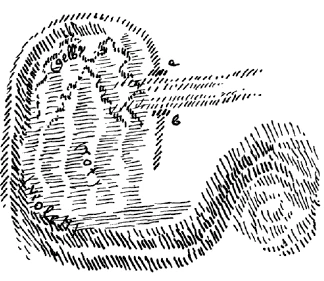
Take, let us say, a certain interior space. I want to keep things as simple as possible. Let us take an interior space that perhaps has a window here (see drawings a, b). Through this window, let us assume, light would fall into this interior space, this light would spread in different ways inside. But let us assume that the interior is filled with all kinds of permeable walls, a kind of permeable vault. So we would have an interior that is filled in the most diverse ways with such vaults, whereby the light is partially transmitted and partially reflected in the most diverse ways, so that this interior would be filled with a light that is reflected and stopped in the most diverse ways.
Now imagine that I would let vapors flow through this inner space, and then let them flow up (red). But this vapor would be alive, it would be a living, sentient being. It would flow upwards and then, let us say, have an outlet, so that it could flow away again. It would flow through this light and into this inner space, into glittering light, into light that is variously modified by these vaults, light that falls through and is reflected. The vapor would feel what it perceived in the light and then flow away. In other words, the vapor would feel what was present in the inner space as a glimmer of light and in this way would get an inner image. It would get an image in its sensation of what is inside, glimmering in the light.
Now let us assume that after some time the steam, by flowing out again, would be able to reproduce what it has experienced inside (violet). We could have a kind of instrument through which the steam would somehow, say by striking musical tones or the like, express what it has experienced inside in the glittering, glowing light. Imagine this picture.
And now I will draw this picture for you in a different way. You see, instead of the vault, I have drawn the inside of the human head, and instead of the window, the eye through which one sees, through which the impressions of light come. What I have drawn as a vault are the convolutions of the brain, the spreading nerves. The light enters there and spreads out. Instead of the vapor that I have drawn there (see page 92), imagine the inhaled air that flows up and scans what can glimmer and glisten in the brain through the light, and what then forms into thoughts in the brain. The air flows back down through the spinal canal. Instead of there being an instrument, there is the human larynx and it can give expression to what has been experienced. There you have a picture of what actually goes on in the human head.
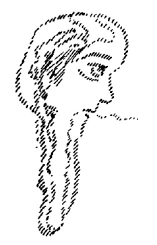
But now we say: Now we don't do it that way, but we close the window here, creating an inner, completely dark vault. So we close the window, now we have this inner vault, and again let steam flow upwards (red). Now, not the light is perceived, which falls in (see first drawing) and is attenuated in various ways, falls back, but now the forms that are there inside are perceived as such. And as the sentient vapor rises, it will be able to perceive the forms that someone once made in there, let's say that a builder once made. So this vapor will be able to feel the actions of this builder. When the vapor then flows out, it can in turn express (red) what has been perceived as the actions of the builder.
But let us assume that this master builder had built in a very special way. Let us assume that this master builder was an extraordinarily universal master builder, and he had made what he had built in there an image of the whole universe. Then, if you just close the window, the vapor inside would sense the secrets of the whole universe. Otherwise, it perceives what glitters in from the outside; but if you close it, it perceives what is inwardly an image of the whole universe.
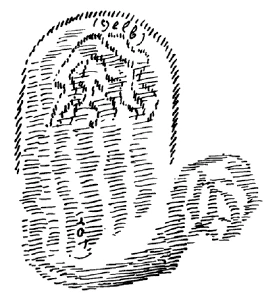
Imagine, then, that we have here an image of the universe (see drawing). In the human head, in the wonderful convolutions of the brain, we really do have an image of the whole universe. And if we close our senses and then let the inhaled air, which goes through the spinal cord into the head, flow through, there is a way to sense the secrets of this brain interior. But you can't just let the inhaled air sense in a disorderly, chaotic way - then you won't find out anything - but it has to be done in an orderly way.
You know, if you want to detect, say, silk, you have to feel in a certain way. You have to accommodate what you want to feel. But if you can do that, if you can accommodate what you want to feel, then you can definitely find what is there to be felt.
In the time of which I have spoken to you in these days, when people wanted to come to higher knowledge by regulating their breathing process, in the time when the old yoga system of the Orient was really in its prime — because what is spoken of today as the yoga exercise is often a mere secondary thing — there was indeed the awareness: When you inhale, when you send the air you breathe into your head, you can grasp the secrets of the universe in the image of this universe, in the particular distribution of the nervous system in your head. You just have to behave in the appropriate way with the inhalation process.
I am not speaking now of what later occurred in a decadent way, but of the original. And the original was this. One said to oneself: When one inhales and shapes the breath so that one sends it up into this inner vault of the head, which is an imprint of the whole universe, but so that one puts a sound into the inhaled air that is between a and o or between a and u. So when you breathe in the sound a-u, you shape your breath so that, just as the hand is suited to sense something on the outside, the sound is suited to sense the secret of the world on the inside. And you get it into your consciousness if you then continue this breathing process in such a way that you let it run its course in an absolutely devotional mood towards what you have sensed. When you have what you attain by inhaling, by sending out the inhaled air and sensing with it in the a-u, when you then place yourself in a devotional mood, become devoted to the world, and pour out what you have sensed there into an absolute devotion, and then letting the breathing process run its course in “m”, then in such a breathing process, which forms inwardly into “aum”, one has caught - from the reproduction, from the nervous reproduction of the universe within - the secret of the universe. And you have brought it to life, which can become conscious in the air exhaled in the sound “m”. In what I have now discussed, you have a clue to what the original yoga training started from.
This yoga training said to itself: In my head is the secret of the whole universe. I can sense it by inhaling. In inhaling, the secret of the universe is revealed through myself. I grasp it, this secret of the universe. But I can only keep it — otherwise it remains in the unconscious — if I then live in absolute devotional surrender to the universe. And so it is recognized that by shaping the inhalation process, the world word is created, that which creatively pervades and interweaves the world, and by grasping this and breathing it out in absolute devotion to the universe: inhalation is the revelation of the world word, exhalation is the inward condensation of the world word, the confession to the world word. Thus is summarized man's exploration of the World Word and man's formulation of the World Word, in that it is realized: inhalation is revelation, exhalation is confession, and “aum” is the synthesis of revelation and confession, the invigoration of the world secret within, the confession of this world secret within.
For us today, in our present epoch, the tone has moved up further. The tone is lived out in real, concrete, not in intellectualized thoughts. So that we can say: inhalation becomes thought, and exhalation becomes the willful living out of the thought. That is to say, we break down what was once inhalation as revelation and exhalation as confession into exercises of thought and of the will, and thus we receive - likewise in thoughts, but in the thoughts practiced in meditation - the revelation, and in the exercises of the will, which after all are carried out on the other side, we receive the confession to what has been revealed.
For modern man it is as follows: what has been experienced in the mere breathing process, and what has been formed into vowel sound in the inhalation process and into consonant sound in the exhalation process, is lived out in a more soul-oriented way in the inwardly contemplated thought, which is, however, permeated by the will in devotional surrender to the universe. So the process is the same, only spiritualized and internalized. But here too, the process consists in perceiving the inner experience of the universe in its secrets and confessing to this universe, to the spiritual foundation of this universe.
We can also consider the following thoughts. We can say: Man is born out of the light, and his inner being, the inner being of his head, is the result of the light. The whole nervous system is, after all, the result of light. Light is not only transmitted through the eye, but also through the other senses. The eye is only the organ that conveys light in the most fundamental sense. We cannot say of blind people that they are completely cut off from light. Light works in them; it is only their conscious perception of light that is gone.
And sound, actually lives in the whole organism. Sound lives in us. Sound does not live only in the ear; the ear is only an organ of perception for sound. When we experience a sound, we experience it with our whole organism. We always experience a symphony with our whole organism. When we listen to a piece of music, the inner process is actually the following: We bring our breathing into a very definite rhythm, into very definite musical processes, which are prompted by the composition. These formations of our respiratory system strike the forms of the brain; the way they are reflected back gives us the musical impression. There is actually always a sensing of light through sound within us.
Please bear in mind that a sensing of the light through sound is constantly taking place in us. The world of sound in us, the sounding organism, is actually a sensing organ for the light. The light is actually always the external, the sound is actually always the internal.
Thoughts – inhalation: revelation
will – exhalation: confession
Sensing the light -> the outer through sound -> the inner
Sensing world thoughts through the human will.
The inner senses probe the outer. We grasp our own nature correctly only when we see ourselves as a special being, set apart from the harmony of the spheres of the world. This being gropes in the light, and in the configurations of light the sound recognizes the essence of the world. It is only in our epoch that we actually have a sensing of world-thoughts through human will (see diagram). We sense the world-thoughts with the will. The will stands here instead of the tone. The thought stands on the other side instead of the light. As I said, these things are very difficult to express in intellectualistic-abstract forms. But what I have tried to present to you figuratively will help you to understand these things if you reflect on them a little and realize that man's standing in the world is truly such that man has in his head an image of the whole cosmos. Man is indeed, in relation to his head, an image of the whole cosmos.
As the human embryo is formed in the mother's womb, it is also initially formed as an image of the cosmos. The first thing is that, yes, in the mother's body, the human being is formed as an image of the cosmos. At first, the human being is basically a brain, an image of the cosmos. You can study the cosmos by studying the human embryo in its earliest stages. Later, what is no longer an image of the cosmos comes over him, but what must be described as follows: if you have the earth here, on it the human being, then - by taking a piece from the embryo - what powers, parallel to the surface, circle the earth in rhythms, are added. The thoracic organism is formed, which is actually created from currents that circle around the earth. You have, if you will, reproduced these currents in the ribs. The effect of the earth organism itself comes last of all. The currents are sent up from below: you have the exact expression of how these currents run in the two legs. So that I can draw the human being as currents emanating from the earth, as currents orbiting the earth, connected to his chest organization, and at the top as a head, the image of the whole universe.
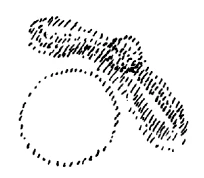
What takes place in the head is actually always a reflection of the whole universe, throughout life. Man, because he has the head organization, carries within himself a reflection of the whole universe. He only has to perceive it. He would not perceive it if he were not organized from the earth to do so. Actually, the earth perceives the universe through man: the chest organism is the mediator. The inhalation is effected from the cosmos, the exhalation from the earth. The cosmos gives us pure oxygen, the earth causes this oxygen to combine with carbon and thus form the deadening exhaled air. But as this dead air is formed, it is perceived.
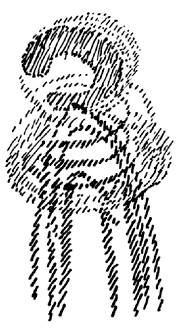
Comprehension always has to do with the dying part of the human being. We actually die through our comprehension; we live through the cosmos. But we would live very quickly if we were only devoted to the cosmos. The cosmos provides us with the most life during our embryonic state, then the earth's circumference gradually takes us to work, and later on what flows up from the earth. In this way, the cosmos imparts to our organism the life it gives us until the quantum of life that the cosmos gives us is used up. The cosmos gives us life, the earth kills us as a physical organism and also as an etheric organism. It is just that the cosmos has its share in our etheric organism, while our earth has its share in our physical organism.
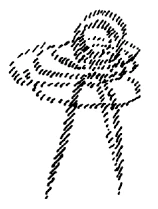
If you consider all this and say to yourself: once upon a time a regulated breathing process was carried out to cultivate higher knowledge, for the purpose of exploring the secrets of the universe within man, then you will realize how, in the times of original human endeavors, man inwardly felt inwardly, how he is connected with the whole universe, and how he wanted to experience the word of the universe through the inhalation process, wanted to sacrifice to the word of the universe through the exhalation process; how he wanted to place himself in the yoga breathing in the world process with his consciousness. Unconsciously, of course, he is always part of this world process. From the external description of this yogic breathing given today, one does not really gain any real knowledge of what was actually striven for with it. But one does gain such real knowledge by penetrating to such knowledge through today's anthroposophical spiritual science. People have no documents about the way it originally was. In the periods for which we have documents, these things no longer existed in their original form. We must arrive at the real secrets of the origin of man on earth without documents, otherwise we must abandon the attempt. So anyone who wants to find out about things only through external documents that have been preserved from older times will not find out about them, but only someone who can look back on much more original conditions than those that are attested by external documents. The secret of the oriental Aum prayer, if I may call it that – I might just as well say the Aum formula of knowledge, for both were contained in it – can only be grasped if one really knows the connection between man and the world in inhaling and exhaling. When one knows that the air, which otherwise gives no particular sounds, is formed into certain sounds as soon as one has differently tuned strings, that in the same way the inhaled air, which one sends with the Aum sound through the brain, inwardly expresses the whole secret of the world, when one knows this, then one knows the connection between man and the universe. One gropes for how one actually came into being. Before his conception, the human being lived in the spiritual-soul world, and in the spirit world. But now, as he descends, he passes through the entire configuration of the cosmos in the ether, gathering the ether. In this moment, he takes in all the secrets of the universe and gradually imprints them on his brain. And the very young child actually imprints what the soul has experienced of the total mystery of the universe, little by little, into the brain. And later on, this secret can be found again when one strives to experience this cosmic secret inwardly – in the breathing air in ancient times and now with the thought.
The power of thought, which is nothing other than a rarefied form of the power of breathing, also configures itself when it is truly channeled through the brain. Modern man does not do this. Modern man does not actually direct the power of thought through the brain, but he hears the words spoken in his language everywhere, and in them the thoughts also live, and then he passes through himself what he inwardly repeats from his national heritage. And in doing so, he acquires no inner knowledge at all, but at most writes books about the fact that one has only language, and cannot recognize anything through language. He then writes a critique of language because he has no idea what the power of thought encounters, because he only knows what is, so to speak, recorded in words. The modern human being is, after all, only a sounding board for words. And if he is then perceptive, like Fritz Mauthner, then he writes books about it, that words actually contain nothing of the essence of the world.
But with that you don't get close to the human being. And you don't get close to the world, especially not to the relationship between the human being and the world. You have to be clear about the fact that it is a profound truth that the human being is “human” through the divine breath, through the inhaled air. Because through that, through this inhaled air, he discovers the whole world within himself, he discovers how he is a microcosm.
If you reflect on what I have just explained today, you will see that you will gradually come across very significant connections. You just don't have to believe that it was a quirk that I initially just painted a picture. It is necessary not to characterize these things with our abstract words, but to try to approach them through images.
I believe I have given you a very important chapter of anthroposophical spiritual science, which I will develop further tomorrow.
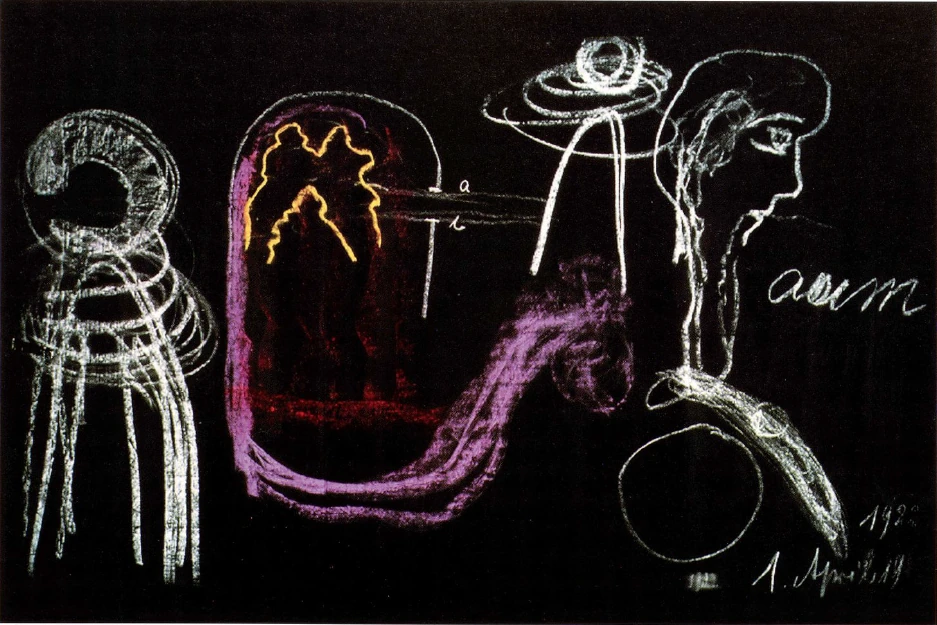
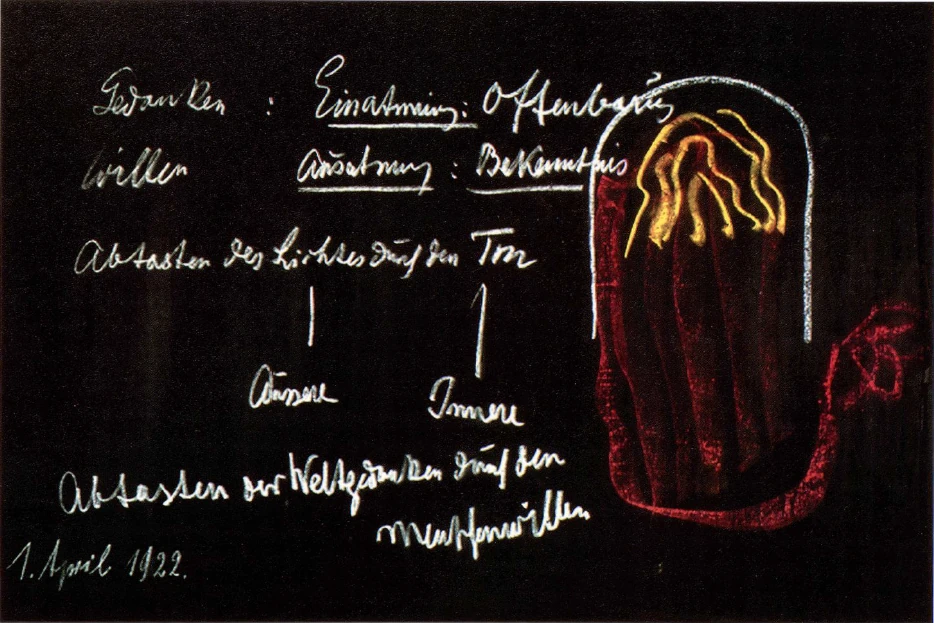
VI. Die Erkundung und Formulierung des Weltenwortes in der Ein- und Ausatmung
Gewisse Dinge können nur dargestellt werden, wenn man versucht, durch Bilder an die entsprechende Wirklichkeit heranzukommen. Man muß gewissen Dingen gegenüber darauf verzichten, in jener abstrakten, intellektualistischen Weise zu sprechen, in der zu sprechen man heute gewöhnt ist. Man würde in dieser intellektualistischen Weise dasjenige, von dem ich Ihnen heute gerade sprechen will, gar nicht darstellen können. Das also sei durchaus vorausgesetzt für die ganze Art der Darstellung, die ich heute geben will.

Nehmen Sie einmal, sagen wir, einen gewissen Innenraum. Ich will die Sache so einfach wie möglich machen. Nehmen wir einen Innenraum, der vielleicht hier ein Fenster hat (siehe Zeichnung a, b). Durch dieses Fenster, nehmen wir an, fiele in diesen Innenraum Licht herein, dieses Licht breitete sich in verschiedener Weise innen aus. Aber der Innenraum, nehmen wir an, sei ausgefüllt mit allerlei durchlässigen Wänden, einer Art durchlässigem Gewölbe. Wir hätten also einen Innenraum, der in der verschiedensten Weise ausgefüllt wäre mit solchen Gewölben, wodurch in der verschiedensten Weise das Licht zum Teil durchgelassen, zum Teil zurückgeworfen wird, so daß dieser Innenraum erfüllt wäre mit einem in der verschiedensten Weise aufgehaltenen, zurückgeworfenen Lichte.
Nun denken Sie sich, ich würde durch diesen Innenraum Dämpfe strömen lassen, würde sie dann hinaufströmen lassen (rot). Dieser Dampf aber, der wäre lebendig, der wäre ein lebendiges, fühlendes Wesen. Der strömt hinauf und hätte wiederum, sagen wir, einen Abzugskanal, würde also wiederum wegströmen können. Er strömt also durch dieses Licht hindurch und strömt hinein in diesen Innenraum, in glitzerndes Licht, in verschiedentlich durch diese Gewölbe hier verändertes, durchfallendes, zurückgeworfenes, glitzerndes Licht. Der Dampf, der würde also fühlen, was er da in dem Lichte wahrnehmen würde, und dann abströmen. Das heißt aber mit anderen Worten: Dieser Dampf würde abtasten mit seinem Gefühl das, was da als Lichtglitzern in dem Innenraum vorhanden wäre, und er würde auf diese Weise ein inneres Bild bekommen. Er würde in seiner Empfindung ein Bild bekommen von dem, was da lichtglitzernd im Innern ist.
Nehmen wir nun an, der Dampf würde nach einiger Zeit, indem er wiederum ausströmt, wiedergeben können, was er da drinnen erfahren hat (violett). Wir könnten eine Art von Instrument haben, durch das der Dampf irgendwie, sagen wir durch Anschlagen von musikalischen Tönen oder dergleichen, zum Ausdrucke bringen würde, was er da drinnen im glitzernden, glimmenden Lichte erfahren hat. Stellen Sie sich dieses Bild vor.
Und nun will ich Ihnen dieses Bild auf eine andere Art aufzeichnen. Sie sehen, ich habe Ihnen statt desGewölbes hier das Innere des menschlichen Hauptes aufgezeichnet, statt des Fensters das Auge, durch das gesehen wird, durch das also die Lichteindrücke kommen. Das, was ich da als Gewölbe gezeichnet habe, sind die Windungen des Gehirnes, die sich ausbreitenden Nerven. Das Licht kommt da herein und breitet sich aus. Statt des Dampfes, den ich dort gezeichnet habe (siehe Seite 92), denken Sie sich die eingeatmete Luft, die heraufströmt und die abtastet, was im Gehirn durch das Licht glitzern, glimmen kann, was im Gehirn sich dann zu Gedanken gestaltet. Die Luft strömt wiederum durch den Rückenmarkskanal herunter. Statt daß da ein Instrument ist, ist der menschliche Kehlkopf da und kann zum Ausdrucke bringen, was erlebt worden ist. Da haben Sie ein Bild von dem, was tatsächlich vorgeht im menschlichen Haupte./

Nun aber sagen wir: Jetzt machen wir das nicht so, sondern wir machen einmal das Fenster hier zu, stellen ein innerlich ganz finsteres Gewölbe her. Wir machen also das Fenster zu, haben nun diese inneren Gewölbe hier, und lassen wiederum Dampf hinaufströmen (rot). Jetzt wird nicht das Licht wahrgenommen, was hereinfällt (siehe erste Zeichnung) und in der verschiedensten Weise abgeschwächt wird, zurückfällt, sondern jetzt werden die Formen, die da drinnen sind, als solche wahrgenommen. Und indem der empfindende Dampf aufströmt, wird er da drinnen die Formen wahrnehmen können, die jemand einmal gemacht hat, sagen wir, die einmal ein Baumeister gemacht hat. Es wird also dieser Dampf empfinden können die Taten dieses Baumeisters. Wenn der Dampf dann abströmt, so kann er wiederum zum Ausdrucke bringen (rot), was da wahrgenommen worden ist als die Taten des Baumeisters.
Aber nehmen wir an, dieser Baumeister hätte in einer ganz besonderen Weise gebaut. Nehmen wir an, dieser Baumeister wäre ein ganz außerordentlich universeller Baumeister, und er hätte das, was er da hineingebaut hat, zu einem Abbild des ganzen Weltenalls gemacht. Dann würde, wenn man nur das Fenster zuschließt, der Dampf da drinnen abtasten die Geheimnisse des ganzen Weltenalls. Sonst nimmt er wahr, was da von außen hereinglitzert; wenn man aber zuschließt, _ nimmt er dasjenige wahr, was innerlich ein Abbild des ganzen Weltenalls ist.

Stellen Sie sich also vor, wir haben hier ein Abbild des Weltenalls (siehe Zeichnung). Im menschlichen Haupte, in den wunderbaren Windungen des Gehirnes haben wir ja wirklich ein Abbild des ganzen Weltenalls. Und wenn wir die Sinne zuschließen und dann die Atemluft, die ja durch den Rückenmarkskanal in das Haupt geht, durchströmen lassen, so gibt es eine Möglichkeit, die Geheimnisse dieses Gehirn-Innenraumes abzutasten. Nur darf man da nicht die Atemluft einfach in einer ungeordneten, chaotischen Weise tasten lassen - dann bekommt man nichts heraus —, sondern das muß in einer geordneten Weise geschehen.
Sie wissen, wenn man, sagen wir, Seide konstatieren will, so muß man ja auch in einer bestimmten Weise tasten. Man muß entgegenkommen dem, was man ertasten will. Aber wenn man das kann, wenn man entgegenkommen kann dem, was man ertasten will, dann kann man eben durchaus dasjenige finden, was da zu ertasten ist.
In der Zeit, von der ich Ihnen gesprochen habe in diesen Tagen, wo die Menschen durch eine Regulierung ihres Atemprozesses zu den höheren Erkenntnissen kommen wollten, in der Zeit, in der das alte JogaSystem des Orients nun wirklich in seiner Blüte stand — denn das, wovon heute als der Joga-Übung gesprochen wird, das ist ja vielfach ein bloß Sekundäres -, da war tatsächlich das Bewußtsein vorhanden: Wenn du einatmest, wenn du die Atemluft in dein Haupt schickst, so kannst du die Geheimnisse des Weltenalls in dem Abbild dieses Weltenalls, in der besonderen Ausbreitung des Nervensystems in deinem Haupte ergreifen. Du mußt nur in der entsprechenden Weise dich mit dem Einatmungsprozesse verhalten.
Ich spreche jetzt nicht von dem, was später in einer dekadenten Weise da war, sondern von dem Ursprünglichen. Und das Ursprüngliche war dieses. Man sagte sich: Wenn man einatmet und den Atem so gestaltet, daß man ihn hinaufschickt in dieses innere Gewölbe des Hauptes, das ein Abdruck des ganzen Weltenalls ist, aber so, daß man in die Atemluft hineinlegt einen Laut, der zwischen a und o ist oder zwischen a und u, wenn man also a-u hineingibt in die Atemluft, dann formt man sie so, daß so, wie die Hand geeignet ist außen etwas abzutasten, der Ton geeignet wird, das Weltengeheimnis da drinnen abzutasten. Und man bekommt es in das Bewußtsein herein, wenn man dann diesen Atemprozeß so fortsetzt, daß man ihn auslaufen läßt in absolut devotionelle Stimmung gegenüber dem, was man da abgetastet hat. Wenn man also das hat, was man erlangt, indem man einatmet, indem man die Atemluft ausschickt und in dem a-u mit ihr abtastet, wenn man dann in die devotionelle Stimmung sich versetzt, hingebungsvoll zur Welt wird, und dasjenige, was man da erkundet hat, ausgießt in eine absolute Hingabe, dann den Atmungsprozeß auslaufen läßt in «m», so hat man in einem solchen Atmungsprozeß, der sich innerlich formt zu dem «aum», dann aufgefangen - aus der Nachbildung, aus der Nerven-Nachbildung des Weltenalls im Innern — das Geheimnis des Weltenalls. Und man hat es zum Leben gebracht, das bewußt werden kann in der, in dem Laute «m» ausgehauchten Luft. Sie haben in dem, was ich jetzt auseinandergesetzt habe, einen Hinweis darauf,wovon ausgegangen ist einmal die ursprüngliche Joga-Schulung.
Diese Joga-Schulung sagte sich: In meinem Haupte ist das Geheimnis des ganzen Weltenalls. Ich kann es abtasten, indem ich einatme. Im Einatmen wird das Geheimnis des Weltenalls durch mich selbst enthüllt. Ich erfasse es, dieses Geheimnis des Weltenalls. Aber ich kann es nur behalten — es bleibt sonst im Unbewußten liegen -, wenn ich in absolut devotioneller Hingabe an das Weltenall mich dann auslebe. Und so wird denn erkannt, indem gestaltet wird der Einatmungsprozeß zu dem Weltenworte, zu dem, was schöpferisch schaffend die Welt durchwellt und durchwebt, und indem das erfaßt wird und in der absoluten Hingabe an das Weltenall ausgehaucht wird: Einatmung, das ist Offenbarung des Weltenwortes, Ausatmung, das ist innerliche Verdichtung des Weltenwortes, das Bekenntnis zum Weltenwort. So wird zusammengefaßt die Erkundung des Weltenwortes durch den Menschen und die Formulierung des Weltenwortes durch den Menschen, indem erkannt wird: Einatmung ist Offenbarung, Ausatmung ist Bekenntnis, und «aum» ist die Zusammenfassung von Offenbarung und Bekenntnis, das Beleben des Weltengeheimnisses in sich, das Sichbekennen zu diesem Weltengeheimnis in sich.
Bei uns heute, in unserer gegenwärtigen Epoche, ist der Ton weiter heraufgerückt. Der Ton lebt sich aus in den wirklichen, konkreten, nicht in den intellektualistischen Gedanken. So daß wir sagen können: Die Einatmung wird zum Gedanken, und die Ausatmung wird zu dem willentlichen Ausleben des Gedankens. Das heißt, wir zerlegen dasjenige, was einstmals Einatmung als Offenbarung, Ausatmung als Bekenntnis war, in Gedankenübung und Willensübung, und bekommen dadurch - ebenfalls in Gedanken, aber in dem in der Meditation erübten Gedanken - die Offenbarung, und in den Willensübungen, die ja auf der anderen Seite ausgeführt werden, das Bekenntnis zu dem Geoffenbarten.
Für die neuere Menschheit ist es so: Was vorher im bloßen AtmungsProzesse erlebt worden ist, und was im Einatmungsprozesse zum Vokalton, im Ausatmungsprozesse zum Konsonantenton geformt worden ist, das lebt sich auf mehr seelische Art aus in dem innerlich kontemplierten Gedanken, der aber vom Willen durchdrungen wird in devotioneller Hingabe an das Weltenall. So ist der Prozeß derselbe, nur verseelischt, verinnerlicht. Aber auch hier besteht der Prozeß darin, daß wahrgenommen wird das innerliche Erleben des Weltenalls in seinen Geheimnissen und das Bekennen zu diesem Weltenall, zu der geistigen Grundlage dieses Weltenalls.
Wir können auch noch folgende Gedanken vor uns hinstellen. Wir können sagen: Der Mensch wird aus dem Lichte heraus geboren, und sein Inneres, das Innere seines Hauptes ist Ergebnis des Lichtes. Das ganze Nervensystem ist ja Ergebnis des Lichtes. Nicht bloß durch das Auge, sondern auch durch die anderen Sinne wird Licht vermittelt. Das Auge ist nur dasjenige, was im hauptsächlichsten Sinne Licht vermittelt. Wir können von blinden Menschen nicht sagen, daß sie vom Lichte ganz abgeschlossen sind. Das Licht arbeitet in ihnen; es ist nur ihre bewußte Wahrnehmung des Lichtes weg.
Und der Ton, der lebt eigentlich im ganzen Organismus. Der Ton lebt in uns. Der Ton lebt nicht nur im Ohre, das Ohr ist nur ein Wahrnehmungsorgan für den Ton. Indem wir einen Ton erleben, erleben wir ihn mit dem ganzen Organismus. Eine Symphonie erleben wir immer mit dem ganzen Organismus. Wenn wir einem Musikstück zuhören, so ist eigentlich der innere Vorgang der folgende: Wir versetzen unseren ganzen Atmungsprozeß in eine ganz bestimmte Rhythmik, in ganz bestimmte musikalische Vorgänge, die eben durch die Komposition veranlaßt werden. Diese Gestaltungen unseres luftförmigen Inneren schlagen an die Formen des Gehirnes an; wie sie da zurückgestoßen werden, das gibt uns den musikalischen Eindruck. Es ist eigentlich immer in uns ein Abtasten des Lichtes durch den Ton.
Halten Sie das fest, daß in uns fortwährend stattfindet ein Abtasten des Lichtes durch den Ton. Die Tonwelt in uns, der tönende Organismus, der ist eigentlich ein Tastorgan für das Licht. Das Licht ist eigentlich immer das Äußere, der Ton ist eigentlich immer das Innere.
Gedanken — Einatmung: Offenbarung
Willen — Ausatmung: Bekenntnis
Abtasten des Lichtes -> Äußeres durch den Ton -> Inneres
Abtasten der Weltgedanken durch den Menschenwillen.
Das Innere tastet das Außere ab. Wir fassen uns unserem Wesen nach eigentlich auch nur in der richtigen Weise, wenn wir uns als ein Spezialwesen, herausgehoben aus der Sphärenharmonie der Welt, erfassen. Dieses Wesen, das tastet im Lichte herum, und in den Konfigurationen des Lichtes erkennt der Ton das Wesen der Welt. Nur in unserer Epoche ist es so, daß wir eigentlich ein Abtasten der Weltgedanken durch den Menschenwillen haben (siehe Schema). Wir tasten mit dem Willen die Weltgedanken ab. Der Wille steht hier statt des Tones. Der Gedanke steht nach der anderen Seite statt des Lichtes. Wie gesagt, diese Dinge sind sehr schwer in intellektualistisch-abstrakte Formen zu bringen. Aber das, was ich bildlich vor Sie hinzustellen versuchte, das wird Sie in diese Dinge hineinbringen, wenn Sie ein wenig darüber nachsinnen, wenn Sie sich klar werden, daß das Darinnenstehen des Menschen in der Welt wirklich so ist, daß der Mensch in seinem Haupte ein Abbild hat des ganzen Kosmos. Der Mensch ist in der Tat in bezug auf sein Haupt ein Abbild des ganzen Kosmos.
Indem der menschliche Embryo im Mutterleibe gebildet wird, wird er auch zunächst als ein Abbild des Kosmos gebildet. Das erste ist, daß ja im Leibe der Mutter der Mensch als ein Abbild des Kosmos gebildet wird. Zuerst ist der Mensch im Grunde genommen Gehirn, Abbild des Kosmos. Sie können den Kosmos studieren, indem Sie den menschlichen Embryo in seinen ersten Stadien studieren. Erst später kommt über ihn das, was nun nicht mehr ein Abbild des Kosmos ist, sondern was man so beschreiben muß: Wenn Sie hier die Erde haben, darauf den Menschen, so tritt — indem ein Stück genommen wird vom Embryo - hinzu das, was an Kräften, parallel der Oberfläche, die Erde in Rhythmen umkreist. Es wird der Brustorganismus gebildet, der eigentlich aus Strömungen geschaffen wird, die um die Erde herumkreisen. Sie haben ja, wenn Sie wollen, diese Strömungen noch in den Rippen nachgebildet. Zuallerletzt kommt die Wirkung des Erdenorganismus selber. Da werden die Strömungen von unten heraufgeschickt: Sie haben ja in den beiden Beinen ganz genau den Ausdruck davon, wie diese Strömungen verlaufen. So daß ich den Menschen zeichnen kann als Strömungen, die von der Erde ausgehen, als Strömungen, die die Erde umkreisen, die mit seiner Brustorganisation zusammenhängen, und oben als Kopf, das Abbild des ganzen Weltenalls.

Was sich im Kopfe abspielt, ist eigentlich immer ein Abbild des ganzen Weltenalls, durch das ganze Leben hindurch. Der Mensch, indem er die Kopforganisation hat, trägt in sich ein Abbild des ganzen Weltenalls. Er muß es nur wahrnehmen. Er würde es nicht wahrnehmen, wenn er nicht von der Erde aus dazu organisiert wäre. Eigentlich nimmt die Erde das Weltenall durch den Menschen wahr: der Brustorganismus ist die Vermittelung. Vom Kosmos herein wird die Einatmung bewirkt, von der Erde wird die Ausatmung bewirkt. Der Kosmos gibt uns den reinen Sauerstoff, die Erde bewirkt, daß sich dieser Sauerstoff durchdringt mit Kohlenstoff und so zu der totmachenden, ausgeatmeten Luft formiert wird. Aber indem diese Totenluft da gebildet wird, wird begriffen.

Das Begreifen hat immer zu tun mit dem Absterbenden im Menschen. Wir sterben eigentlich durch unser Begreifen, wir leben durch den Kosmos. Aber wir würden sehr rasch leben, wenn wir nur dem Kosmos hingegeben wären. Der Kosmos versorgt uns am meisten mit Leben noch während unseres Embryozustandes, dann nimmt uns allmählich der Umkreis der Erde in Arbeit, später das, was von der Erde heraufströmt. Dadurch wird dasjenige vermittelt, was der Kosmos unserem Organismus an Leben gibt, bis das Quantum von Leben, das uns der Kosmos gibt, eben aufgezehrt ist. Der Kosmos belebt uns, die Erde tötet uns als physischen Organismus und auch als ätherischen Organismus. Nur ist es so, daß an unserem ätherischen Organismus vorzugsweise der Kosmos seinen Anteil hat, an unserem physischen Organismus hat vorzugsweise unsere Erde ihren Anteil.

Wenn Sie das alles bedenken und sich sagen: Einmal wurde zur Pflege des höheren Wissens ein geregelter Atmungsprozeß vollzogen, zu dem Zwecke vollzogen, um die Geheimnisse des Weltenalls im Menschen zu erkunden, dann werden Sie darauf kommen, wie in den Zeiten ursprünglicher Menschenbestrebungen der Mensch innerlich fühlte, wie er zusammenhängt mit dem ganzen Weltenall, und wie er erleben wollte das Weltenwort durch den Einatmungsprozeß, opfern wollte dem Weltenworte durch den Ausatmungsprozeß; wie er sich hineinstellen wollte im Joga-Atmen in den Weltenprozeß mit seinem Bewußtsein. Unbewußt steht er ja natürlich stets drinnen in diesem Weltenprozeß. Aus der äußeren Beschreibung, die heute gegeben wird von diesem Joga-Atmen, erlangt man keine wirkliche Erkenntnis darüber, was damit eigentlich angestrebt worden ist. Aber man erlangt eine solche wirkliche Erkenntnis dadurch, daß man sich durch die heutige anthroposophische Geisteswissenschaft zu solcher Erkenntnis durchringt. Die Menschen haben keine Dokumente über die Art und Weise, wie das ursprünglich war. In den Zeiten, aus denen man Dokumente darüber hat, da waren diese Dinge schon nicht mehr in der ursprünglichen Weise vorhanden. Auf die eigentlichen Geheimnisse des Menschenursprungs auf der Erde muß man ohne Dokumente kommen, sonst muß man darauf verzichten. Wer also nur durch äußere Dokumente, die sich erhalten haben aus älteren Zeiten, auf die Dinge kommen will, der kommt eben nicht darauf, sondern lediglich der wird darauf kommen, der zurückschauen kann auf viel ursprünglichere Zustände als diejenigen, die durch äußere Dokumente bekundet werden. Auf das Geheimnis des orientalischen Aum-Gebetes, wenn ich es so nennen darf - ich könnte ebensogut sagen: der Aum-Erkenntnisformel, denn beides war darinnen -, kommt man nur, wenn man den Zusammenhang des Menschen mit der Welt in Ein- und Ausatmen wirklich kennt. Wenn man weiß, daß, wie die Luft, die sonst eben durchaus nicht bestimmte Töne gibt, zu bestimmten Tönen geformt wird, sobald man verschieden gestimmte Saiten hat, daß ebenso die eingeatmete Luft, die man mit dem Aum-Laute durch das Gehirn schickt, innerlich das ganze Weltengeheimnis ausdrückt, wenn man das weiß, dann kennt man den Menschenzusammenhang mit dem Weltenall. Man tastet ab, wie man eigentlich geworden ist. Indem der Mensch vor seiner Empfängnis in der geistig-seelischen Welt gelebt hat, war er ja eben in der Geistwelt. Aber indem er jetzt heruntersteigt, geht er durch die ganze Konfiguration des Kosmos im Äther durch, sammelt sich den Äther. In diesem Momente nimmt er alle Geheimnisse des Weltenalls auf, prägt sie dann nach und nach in sein Gehirn ein. Und das ganz kleine Kind prägt eigentlich noch das, was die Seele vom Gesamtgeheimnis des Weltenalls erlebt hat, nach und nach in das Gehirn hinein. Und später findet man wiederum dieses Geheimnis, wenn man - in alten Zeiten in der Atemluft und jetzt mit dem Gedanken - innerlich dieses Weltengeheimnis wiederum zu erleben strebt.
Es konfiguriert sich auch die Gedankenkraft, die ja nichts anderes ist als eine verdünnte Atemkraft, wenn sie wirklich durch das Gehirn geleitet wird. Der moderne Mensch tut das nicht. Der moderne Mensch leitet eigentlich nicht Gedankenkraft durch das Gehirn, sondern er hört überall die Worte, die in seiner Sprache gesprochen werden und in denen auch so die Gedanken drinnen leben, und dann leitet er das, was er innerlich nachplappert aus seinem Nationalbestand, durch sich durch. Und dabei erobert er sich gar nichts an inneren Erkenntnissen, sondern schreibt höchstens dann Bücher darüber, daß man ja nur die Sprache hat, und durch die Sprache nichts erkennen kann. Er schreibt dann eine Kritik der Sprache, weil er keine Ahnung davon hat, worauf die Gedankenkraft stößt, weil er nur weiß, was gewissermaßen aufgezeichnet ist in den Worten. Der moderne Mensch ist ja nur ein Resonanzboden für die Worte. Und wenn er dann scharfsinnig ist, wie Fritz Mauthner, dann schreibt er eben Bücher darüber, daß die Worte ja eigentlich nichts vom Wesen der Welt enthalten.
Aber damit kommt man dem Menschen nicht nahe. Und man kommt der Welt nicht nahe, insbesondere nicht dem Verhältnis des Menschen zur Welt. Man muß sich schon klar darüber sein, daß es ein tiefes Wahrwort ist, daß der Mensch «Mensch» ist durch den göttlichen Odem, durch die eingeatmete Luft. Denn dadurch, durch diese eingeatmete Luft, entdeckt er die ganze Welt in sich, entdeckt er, wie er ein Mikrokosmos ist.
Wenn Sie das, was ich gerade heute dargelegt habe, nach allen Seiten durchsinnen, dann werden Sie sehen, daß Sie auf ganz bedeutsame Zusammenhänge nach und nach gestoßen werden. Sie müssen nur nicht glauben, es sei so eine Schrulle, daß ich zunächst bloß ein Bild hingemalt habe. Es ist schon notwendig, daß man nicht mit unseren abstrakten Worten diese Dinge charakterisiert, sondern daß man dem Tatbestande durch Bilder nahezukommen sucht.
Damit habe ich Ihnen, wie ich glaube, ein sehr wichtiges Kapitel der anthroposophischen Geisteswissenschaft angedeutet und werde es dann morgen weiter ausgestalten.



